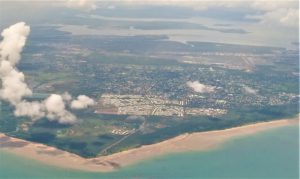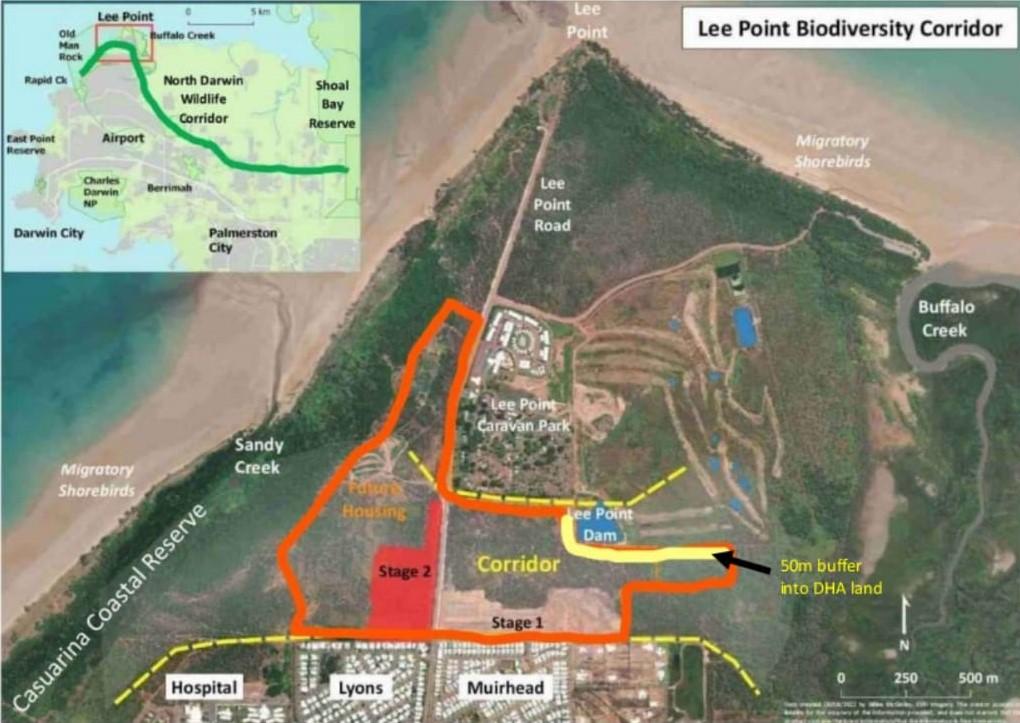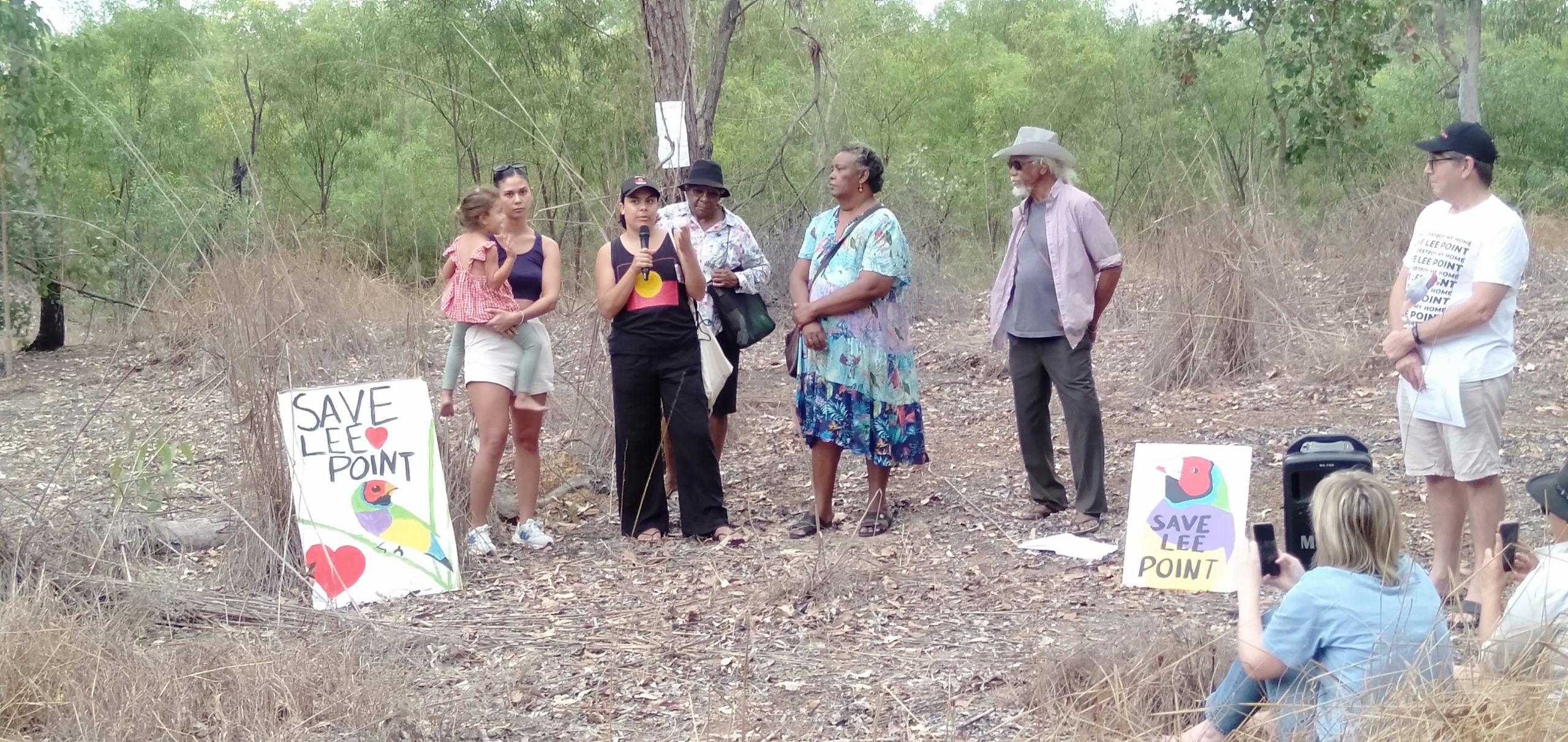Planning for Lee Point peninsula, Darwin NT
A comprehensive Area Plan for the whole of Lee Point peninsula needs to be completed before any significant development should be allowed.
1.0 Background
There are very few cities in the world that have a reserve like Lee Point on their doorstep. It makes Darwin a special place.
Lee Point peninsula is enjoyed by families, nature lovers, mountain bike riders, birdwatchers, fishermen, campers, bush walkers and tourists. It offers unique recreation and tourism opportunities to promote Darwin and is one of Darwin’s most important natural and cultural assets.

Lee Point peninsula March 2021, photo by Teresa Laird
Lee Point is located 17 km from Darwin’s CBD on a five square kilometre peninsula which has helped conserve its natural beauty and biodiversity.
2.0 What makes Lee Point peninsula special is:
- High value to locals and visitors – it contains over half of Casuarina Coastal Reserve (CCR). CCR attracts over one million visits each year (Appendix – Ref 1) and is the most visited park/reserve in the NT because of its natural beauty, rich biodiversity and accessibility.
- Rich biodiversity – habitats range from beach, mangrove, open eucalypt forests, paperbark forests, rainforest, and include internationally significant migratory shorebird sites. It is an integral part of Darwin’s last wildlife corridor, home to a number of threatened species, and has recorded a similar number of bird species to Kakadu (which is 4000 times larger in area).
- Cultural and heritage aspects – it is a significant place for the Larrakia people (traditional owners of Darwin) and contains one of their most important sites, Dariba Nungalinya (Old Man Rock). Lee Point played a significant role in the defence of Darwin and has historical defence relics.
- Tourism potential – it could provide valuable employment opportunities for local indigenous people through ecotourism – the fastest growing sector of the world tourism market. About 50% of Lee Point can be used by the public at present but this could be expanded to 90%.
Further information is at: Lee Point: a special part of Darwin
Lee Point/Binybara is on Larrakia land and as such people need to protect, manage and respect the land and surrounding sea. The Australian and NT Government own 90% of Lee Point and 10% is privately owned and operated as a commercial resort/caravan park.
3.0 Defence housing at Berrimah vs Lee Point peninsula
Defence personnel should be housed near jobs and (public) transport where possible. Robertson Barracks is the largest defence base in Darwin.
Holtze (mostly owned by government) and Berrimah – Northcrest (owned by private developer) need to be considered as options due to their proximity to Robertson Barracks. Other options also exist.
Berrimah – Northcrest was chosen here as housing construction is well underway.

Fig 1. showing the larger housing sites (white), defence bases (red) and Darwin Wildlife Corridor (green).
Berrimah – below are the expected benefits of housing defence personnel at one alternative location, the old Berrimah Farm, instead of Lee Point. This is based on information from; Prelim Cost Benefit Lee Point paper (Ref 2), NT EPA website (Ref 3), and recent information.
In summary, there is no net long-term social, environmental or economic benefit from housing defence personnel at Lee Point peninsula compared to Berrimah, in short there is no public benefit.

Fig 2. showing Darwin’s last wildlife corridor (inset), Stage 1 cleared, with Stage 2 next and planned clearing (red border) plus 50m buffer around the dam for the Gouldian Finch.
SOCIAL BENEFITS (from housing people at Berrimah)
Families and visitors will be able to continue to enjoy the natural beauty and biodiversity of the Lee Point peninsula.
Travel – Defence personnel would save about 60-100 minutes each week driving to work from Berrimah instead of from Lee Point and would find it much easier to cycle to work (a healthier lifestyle) or use public transport. It would avoid time spent at the Vanderlin/Lee Point intersection (already a congested traffic area).
Affordable housing – much better access to public transport helps reduce cost-of-living expenses and deliver affordable housing. The current housing project at Lee Point does not provide much needed affordable housing – ref independent housing report.
Health issues – it avoids problems with biting insects from tidal areas and offensive odours from the Leanyer sewage treatment ponds – NT EPA (Sec 5)
Services and entertainment – there are a greater choice of established services and entertainment from the nearby CBDs of Darwin and Palmerston. A future benefit could be more vibrant CBDs through their greater use.
Cultural and heritage – It avoids criticism from Larrakia people (traditional owners of Darwin Region). Larrakia Nation has formally withdrawn support for the Lee Point project. Senior Larrakia elder, Bill Risk does not want Lee Point/Binybara developed and is requesting that housing to be located elsewhere.

Prominent elders (from right) Tibby Quall and Lorraine Williams plus other Larrakia people saying they were never consulted on the Lee Point development and are strongly opposed to having the development at Binybara (Lee Point peninsula).
It protects the cultural and heritage aspects of Lee Point/Binybara for future generations and helps promote ecotourism and interest in Darwin.
The above social benefits will help attract and retain defence service personnel and their families to Darwin. It respects the wishes of the Larrakia people.
ENVIRONMENTAL BENEFITS (from housing people at Berrimah)
Habitat Loss and land use – housing people at Berrimah avoids clearing one square km of habitat that includes some of the last tropical habitat in Darwin, loss of wildlife (includes some endangered species), and considerable impact on Lee Point peninsula (from thousands of people living there). It protects critical habitat and Darwin’s last wildlife corridor.
It avoids criticism from the scientific community. Over 300 scientists and experts have signed an open letter in July 2023 calling on government to immediately halt the Lee Point development and engage with Larrakia Traditional Owners, the community and suitable threatened species experts for the Lee Point development. In September 2023, over 220 delegates from the Society of Ecological Restoration (SER) conference in Darwin signed a recommendation to find an alternative location.
Lee Point has a high biodiversity that offers sanctuary to threatened species. Charles Darwin University believes that Lee Point is vital habit for the endangered Black-footed tree rat species. The unprecedented (endangered) Gouldian Finch population increase at Lee Point in 2022 dry season is another example of its attraction to threatened species. It is highly likely that the Gouldian Finches made use of the tree hollows in the Lee Point old growth trees (150 – 450 years old) to breed.
Impact on Casuarina Coastal Reserve (CCR) – housing people at Berrimah will not cause any additional impact on internationally significant migratory shorebird sites, turtle nesting sites or introduce more cats (resulting in further loss of wildlife) at Lee Point.
C02 emissions – work related car emissions are reduced by 50% at Berrimah. This is due to more people cycling or using public transport and people driving over shorter distances.
ECONOMIC BENEFITS
Increased income (from housing people at Berrimah and promoting tourism)
Increased revenue will flow from developing tourism activities at Lee Point and having people stay longer in Darwin.
No other city in the world can lay claim to having wild Gouldian Finches (arguably the most beautiful finch in the world) on their doorstep. The benefits have barely started to be realised, however, this will not continue if the Lee Point land (habitat) is cleared.*
Many thousands of people (half from interstate) visited Lee Point during May to September 2022 to see the Gouldian Finches. Local tourism operators are now benefiting from this as well as the nearby caravan park.
*Gouldian Finches are currently the major drawcard but it’s the other wildlife at Lee Point that extends peoples stay. Without suitable habitat there is no wildlife.
Decreased expenditure (from housing people at Berrimah)
- Transport cost – it provides a better return on investment for public transport systems and road infrastructure. The traffic problems associated with an urban sprawl are avoided saving money for the taxpayer.
- Water and electricity costs – these are reduced as most of the infrastructure is already established at Berrimah. It also has lower operating costs due to a smaller water and electricity grid (asset size). Berrimah is closer to water and electricity sources which will reduce pumping and transmission costs.
- Environmental costs – these are negligible at the old Berrimah Farm compared to Lee Point. At Lee Point cats and dogs need to be effectively managed to protect wildlife.
Note: Holtze and other places that make better use of existing infrastructure should produce similar savings from having a more compact and efficient infrastructure system (compared to developing Lee Point peninsula).
3.1 Urban Planning
The section below looks at why housing people at Berrimah instead of Lee Point is a much better outcome from an international, government and public perspective.
International – it aligns the housing development with recent United Nations policy on limiting global warming (by reducing CO2 emissions) and loss of biodiversity (Ref 4) plus the November 2021 declaration (from COP26) to halt and reverse forest loss and land degradation by 2030.
Australian Government
A) it aligns the housing development with the 2016 Smart Cities Plan: this plan encourages housing to be located near jobs and transport (Ref 5) and Infrastructure Australia (an independent statutory body) sustainability principles (Ref 6).
B) It supports the Australian Government’s commitment made in Oct 2021 to reach net zero emissions by 2050.
C) It avoids an environmental offset (this should only be used as a last resort) in accordance with the EPBC environmental offset policy
NT Government
A) it supports the NT Government’s stated climate change commitment:
“The Territory Government is committed to taking action on climate change to maximise the economic, social and environmental wellbeing of Territorians” – Northern Territory Climate Change Response: Towards 2050 – July 2020 (Ref 7)
Note: Locating housing at Lee Point is estimated to double work-related car emissions (as compared to locating housing at Berrimah).
B) it aligns with the current (12) NT Planning Act objectives (Ref 8), in particular:
- Objective (b) to ensure that strategic decisions reflect the wishes and needs of the community;
- Objective (e) to promote the sustainable development of land; and
- Objective (h) to protect the quality of life of future generations.
Note: Locating housing at Lee Point does not align with the current NT Planning Act, Smart Cities Plan or Infrastructure Australia sustainability principles.
C) it supports implementing Area Plans by the NT Planning Commission (Commission) – the commission was established by the NT Parliament in 2012 to consult and develop strategic plans for the NT (Ref 9). It has been involved in all the Area Plans (including Berrimah) in the Darwin and Palmerston region with the exception of the 2015 Lee Point Area Plan, “….The Lee Point Area Plan was developed by professional planning consultants on behalf of DHA, in consultation with the Department of Infrastructure, Planning and Logistics..” read more.
D) it avoids an environmental offset (this should only be used as a last resort) in accordance with the NT Government Offsets Framework
Local Government – it supports the City of Darwin’s Climate Emergency Strategy and Greening Darwin Strategy. These strategies include actions on achieving net zero emissions by 2040 and enhancing/protecting the urban forest and biodiversity (Ref 10). In Oct 2021, City of Darwin called for a moratorium on the current DHA housing development at Lee Point until the Northern Territory Planning Commission has developed a comprehensive area plan for Lee Point that reflects the long term wishes and needs of the community.
Public – it addresses public concerns around the lack of democratic process (consultation) and transparency (public benefit reports on locating housing in other locations). These concerns are reflected in the Save Lee Point petition (approx 4500 signatures), many letters to the NT News, and the concerns are growing. Prior to 2020, less than 15% of people in the Darwin northern suburbs (based on a FLP on-line survey of 820 people) were aware that thousands of people were going to be housed at Lee Point.
4.0 Future planning for Lee Point
There is no comprehensive Area Plan for the whole of Lee Point. The 2015 Lee Point Area Plan focusses on the disused defence land or about one quarter of Lee Point (Ref 11).
To date, there has been a relatively minor financial investment in the proposed Lee Point development (future investment approx $400M). The developer (Defence Housing Australia) is wholly owned by the Australian Government (Ref 12). As such, the issue of having no public benefit for the proposed Lee Point development compared to other locations needs to be resolved between levels of government as a matter of priority. The key to addressing this public benefit issue (and the Lee Point Area Plan) is appropriate planning work.
The most appropriate organisation that is best able to assess and report on public benefit of developing land at Lee Point for the NT is the Commission. This is the reason why it was established by the NT Parliament and it reports to parliament each year. Similarly, the Public Works Committee was established by the Australian Government to assess the benefits of public works and report to Parliament. Both of these (independent) organisations have not been involved in Lee Point despite there being a large public investment (total value ~$400M) and public interest in the Lee Point peninsula.
5.0 Summary
Lee Point peninsula is part of what makes Darwin special and is an irreplaceable asset. Much has changed since the Lee Point Area Plan was approved in 2015. As such,
- no significant development should take place at Lee Point peninsula until the NT Planning Commission has completed a comprehensive Area Plan for the whole of Lee Point peninsula,
- no significant public works should proceed until the Public Works Committee has completed a report on its public benefit.
For further information please contact:
Ian Redmond and Gayle Laidlaw
Friends of Lee Point
0427 796 470
Facebook: Friends of Lee Point
APPENDIX
BIBLIOGRAPHY
Ref Title
1. NT Government: Park visitor data
2. Friends of Lee Point: Prelim Cost Benefit paper, Oct 2020
https://saveleepoint.org.au/wp-content/uploads/2021/06/AA-Lee-Point-COST-BENEFIT-14-Oct-2020.pdf
3.NT Environmental Protection Agency: Lee Point Master Planned Urban Development
4. Wikipedia: Global Assessment Report on Biodiversity, May 2019
https://en.wikipedia.org/wiki/Global_Assessment_Report_on_Biodiversity_and_Ecosystem_Services
5. Australian Government: Smart Cities Plan
https://www.infrastructure.gov.au/cities/smart-cities/plan/files/Smart_Cities_Plan.pdf
6. Infrastructure Australia: Sustainability Principals, April 2021
7. NT Government: Climate Change Response to 2050, July 2020
8. NT Government: Planning Act 1999, March 2021
https://legislation.nt.gov.au/en/Legislation/PLANNING-ACT-19999.
9. Northern Territory Planning Commission
https://planningcommission.nt.gov.au/
10. City of Darwin: Greening Darwin Strategy, July 2021
11. NT Government: Lee Point Area Plan
https://nt.gov.au/__data/assets/pdf_file/0006/915576/lee-point-planning-principles-and-area-plan.pdf
12. Australian Government Department of Finance: Defence Housing Australia: https://www.finance.gov.au/business/government-business-enterprises/defence-housing-australia-dha